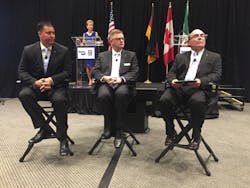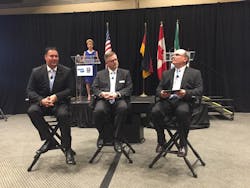Bendix: Truck technology implementation is the real struggle
If there is one lesson the trucking industry should take away from the Tesla car crash last year that occurred when the vehicle was on autopilot, it’s that technology itself might not be the issue – it is how technology gets implemented and ultimately used on a day-to-day basis.
That’s the line of thought Fred Andersky, director of customer solutions for the controls group at Bendix Commercial Vehicle Systems LLC put forth during a press conference at the North American Commercial Vehicle (NACV) show this week.
“The Tesla crash shows that it’s not the technology that is necessarily the concern; it’s the issue of implementing technology,” he explained.
The National Transportation Safety Board determined that a truck driver’s failure to yield the right of way and a car driver’s inattention due to overreliance on vehicle automation were the probable cause of the fatal Tesla crash back in May 2016, near Williston, FL.
The NTSB also determined the operational design of the Tesla’s vehicle automation permitted “over-reliance” on the automation technology allowing for “prolonged disengagement” from the task of driving a vehicle and also enabled the Tesla owner to use the technology in ways “inconsistent” with manufacturer guidance and warnings.
“System safeguards, that should have prevented the Tesla’s driver from using the car’s automation system on certain roadways, were lacking and the combined effects of human error and the lack of sufficient system safeguards resulted in a fatal collision that should not have happened,” noted NTSB Chairman Robert Sumwalt III in a report two weeks ago.
Technology like Tesla’s ‘Autopilot’ system “are designed to assist drivers with specific tasks in limited environments,” he stressed. “These systems require the driver to pay attention all the time and to be able to take over immediately when something goes wrong.”At the NACV briefing, Andersky noted that “autonomy encompasses a number of factors, including the appropriate use, understanding, and implementation of the technology, along with the wider impact of the ecosystem surrounding the application.”
But he added that development of autonomous technology will continue to be encouraged, especially in cars and especially by government agencies like the National Highway Transportation Safety Administration (NHTSA).
“Their basic role is to reduce crashes and save lives and they see a much bigger fish to fry in terms of autonomous cars versus trucks,” he added. “That’s why they are more focused on that [car] side. But there is value for truckers here as cars are the ones crashing into them.”
A University of Michigan Transportation Research Institute (UMTRI study conducted several years ago showed assigned car drivers “factors of fault” in 81% of the car-truck crashes studied, compared with 27% of truckers. Those totals were greater than 100%, UMTRI said, because 10% of crashes assigned blame to both car and truck drivers.
Also from the UMTRI study: Cars were the encroaching vehicle in 89% of head-on crashes; in 88% of opposite-direction sideswipes; in 80% of rear-end crashes and in 72% of same-direction side-swipes, which it said were “obvious indicators of fault.”
Andersky also highlighted another key issue where truck technology implementation is concerned: calculating and acting on its benefits.“Fleets are really just now starting to understand the safety performance benefits and lower total cost of operations (TCO) possible with new technologies,” he explained.
For example, brakes remain the top reason why trucks are placed out of service during the annual 72-hour Roadcheck International safety inspection blitz, representing 26.9 % of all vehicle out-of-service violations. Many of those are due to traditional drum brakes being “out of adjustment,” which is a problem that would be solved by switching over to air disc brakes.
Yet maximize a return on investment due to the higher cost of air disc brakes versus drum brakes, fleets might want to revisit their highay tractor trade cycles, Andersky explained.
“They might move from a typical three year trade cycle – which they may use in part to avoid major drum brake work – and expand to a four or five year cycle to gain the full [TCO] benefit of air disc brakes,” he said.
Berend Bracht, Bendix’s president and CEO, noted during the press conference that air disc brakes are a “building block” where autonomous vehicles are concerned and will “likely one day” be a mandated requirement.
Aside from the technology discussion, Bendix highlighted several product enhancements and other endeavors:
- Bendix Spicer Foundation Brake LLC – a joint venture between Bendix and Dana Commercial Vehicle Products – added a new air disc brake (ADB) production line at its wheel-end manufacturing operation in Bowling Green, KY, which became fully operational early this month and will be ramping up to full capacity through the end of the year. Bendix noted that more than 20% of North American Class 6-8 trucks with air-brake wheel-ends are now equipped with ADBs; a 50% increase in overall market share since 2013
- Bendix is offering a new ADB value calculator, available at ValuebyBendix.com, to help fleets understand what the potential savings might be if they spec ADBs on all wheel positions of their tractors and trailers;
- Bendix is also rolling out “next-generation” drum brakes as a factory-installed option at all major North American medium- and heavy-duty truck manufacturers; brakes that offer weight savings up to 16 lbs. per tandem axle set as they’ve been converted from a “cast spider” to a “heavy-duty stamped spider” design.
- Ford Motor Co. is going to make the Bendix ESP (short for ‘electronic stability program’) electronic stability control package a standard feature on all 2018 model year F-650 and F-750 tractors, plus as an option on certain F-750 straight truck configurations.
- Fleet trials of Bendix’s new Intellipark automatic parking brake system will begin in 2018; a technology designed to help drivers prevent rollaway and runaway crashes caused by an improperly set or disengaged parking brake. It will replace manual air system-based parking brakes with electronic switches. It’s also designed to work on any air-braked vehicle, including tractor-trailers, single-unit trucks, motor coaches, and school buses.
- The company is updating its BlindSpotter Side Object Detection System with a new and “more effective radar unit” that can be integrated into its Wingman Fusion advanced driver assistance technology. Using a passenger side-mounted radar unit, BlindSpotter is designed to alert drivers to vehicles or objects in adjacent lanes. The new version will offer the same look, size, position, and mounting hardware for the radar and in-cab display units but with a significantly wider “field of view,” allowing it to “see” farther toward both the front and back of the combination or single-unit vehicle. It will be available in the first quarter of next year.
- Also in 2018 Bendix said it will offer upgrades to its Wingman Fusion system to include highway departure braking and multi-lane automatic emergency braking, along with strengthened collision mitigation capabilities via the use of automatic braking. Those new options come through software advancements, meaning current Fusion customers will be able to upgrade to the new capabilities with no need to purchase new hardware components. Bendix plans to begin demonstrating the new upgrades prior to the close of 2017 and throughout 2018.
- Bendix will begin offering a new aftermarket heavy-duty drum brake friction pad to help keep their vehicles compliant with reduced stopping distance (RSD) requirements of 250-ft. called the BA232R in early October. It’s designed to handle heavy line haul, heavy pick-up and delivery, severe duty, and refuse applications. In testing, Bendix said its BA232R lining provided an average 235-ft. worth of stopping distance –exceeding the RSD mandate.
- Bendix is also launching a new spring brake line called EnduraSure, which includes an improved version of its standard chamber and is already in production. EnduraSure will replace the EverSure spring brake family.
- In a personnel note, Bendix recently appointed Stephen “Steve” Daukaus to be its vice president of finance and information technology as well as its chief financial officer. Daukaus, who joined Bendix on Sept. 5, also became the newest member of the Bendix Leadership Committee. He fills the position held previously by Arnfred Kulenkampff, who will be retiring at the close of 2017.
About the Author
Sean Kilcarr
Editor in Chief
Sean Kilcarr is a former longtime FleetOwner senior editor who wrote for the publication from 2000 to 2018. He served as editor-in-chief from 2017 to 2018.


